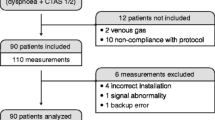Abstract
Abstract
Whereas during the last few years handling of the transcutaneousPO2 (tcPO2) andPCO2 (tcPCO2) sensor has been simplified, the high electrode temperature and the short application time remain major drawbacks. In order to determine whether the application of a topical metabolic inhibitor allows reliable measurement at a sensor temperature of 42°C for a period of up to 12 h, we performed a prospective, open, nonrandomized study in a sequential sample of 20 critically ill neonates. A total of 120 comparisons (six repeated measurements per patient) between arterial and transcutaneous values were obtained. Transcutaneous values were measured with a control sensor at 44°C (conventional contact medium, average application time 3 h) and a test sensor at 42°C (Eugenol solution, average application time 8 h). Comparison of tcPO2 andPaO2 at 42°C (Eugenol solution) showed a mean difference of +0.16 kPa (range +1.60 to −2.00 kPa), limits of agreement +1.88 and −1.56 kPa. Comparison of tcPO2 andPaO2 at 44°C (control sensor) revealed a mean difference of +0.02 kPa (range +2.60 to −1.90 kPa), limits of agreement +2.12 and −2.08 kPa. Comparison of tcPCO2 andPaCO2 at 42°C (Eugenol solution) showed a mean difference of +0.91 (range +2.30 to +0.10 kPa), limits of agreement +2.24 and −0.42 kPa. Comparison of tcPCO2 andPaCO2 at 44°C (control sensor) revealed a mean difference of +0.63 kPa (range 1.50 to −0.30 kPa), limits of agreement +1.73 and −0.47 kPa.
Conclusion
Our results show that the use of an Eugenol solution allows reliable measurement of tcPO2 at a heating temperature of 42°C; the application time can be prolongued up to a maximum of 12 h without aggravating the skin lesions. The performance of the tcPCO2 monitor was slightly worse at 42°C than at 44°C suggesting that for the Eugenol solution the metabolic offset should be corrected
Similar content being viewed by others
Abbreviations
- TcPO 2 :
-
transcutaneous oxygen pressure
- TcPCO 2 :
-
transcutaneous carbon dioxide pressure
References
Bland JM, Altman DG (1986) Statistical methods for assessing agreement between two methods of clinical measurement. Lancet I:307–310
Bucher HU, Fanconi S, Fallenstein F, Duc G (1986) Transcutaneous carbon dioxide tension in newborn infants: reliability and safety of continuous 24-hour measurement at 42°C. Pediatrics 78: 631–635
Bucher HU, Fanconi S, Baeckert P, Duc G (1989) Hyperoxemia in newborn infants: Detection by pulse oximetry. Pediatrics 84:226–230
Cotmore JM, Burke A, Lee NH, Shapiro TM (1979) Respiratory inhibition of isolated rat liver mitochondria by eugenol. Arch Oral Biol 24:565–568
Fanconi S (1988) Reliability of pulse oximetry in hypoxic infants. J Pediatr 112:424–427
Harpin VA, Rutter N (1983) Barrier properties of the newborn infant's skin. J Pediatr 102:419–425
Löfgren O, Jacobson L (1979) The influence of different electrode temperatures on the recorded transcutaneous pO2 level. Pediatrics 64:892–897
Jeny JH, Hahn LJ, Lu FJ, Wang YJ, Kuo MY (1994) Eugenol triggers different pathobiological effects on human oral mucosal fibroblasts. J Dent Res 73: 1050–1055
Patel BT, Delpy DT, Hillson PJ, Parker D (1989) A topical metabolic inhibitor to improve transcutaneous estimation of arterial oxygen tension in adults. J Biomed Eng 11:381–383
Author information
Authors and Affiliations
Rights and permissions
About this article
Cite this article
Fanconi, S., Tschupp, A. & Molinari, L. Long-term transcutaneous monitoring of oxygen tension and carbon dioxide at 42°C in critically ill neonates: improved performance of the tcpo2 monitor with topical metabolic inhibition. Eur J Pediatr 155, 1043–1046 (1996). https://doi.org/10.1007/BF02532528
Received:
Accepted:
Issue Date:
DOI: https://doi.org/10.1007/BF02532528




